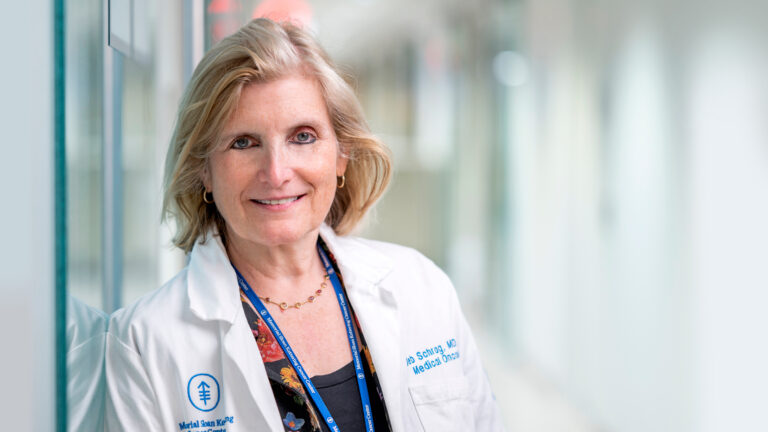The American Cancer Society and the American Society of Clinical Oncology have combined their cancer information resources, which will be available at no cost to the public on cancer.org.
The collaboration, which combines the two organizations’ sites—ACS’s cancer.org and ASCO’s cancer.net—was announced at the 2024 ASCO Annual Meeting in Chicago May 1.
Cancer.org is now the primary website and and all content is branded by ACS and ASCO.
The two organizations said that combining resources would help answer the challenge set forth by President Joe Biden’s Cancer Moonshot initiative: to reduce duplication and find efficiencies to improve the experience of people facing cancer.
In early 2022, the two organizations launched a partnership to provide shared content through cancer.org.
“We started off with, ‘What’s the right thing to do?’” Karen E. Knudsen, CEO of the American Cancer Society, said to The Cancer Letter. “That was the motivation, and I have to say, that was very much accepted by both of our boards as being the right move for cancer patients and families.”
The new cancer.org now becomes the leading information resource provided by nonprofits.
“It certainly requires a lot of effort, humility, and compromise on the part of many, many, many hundreds of people in order for it to actually work,” Clifford A. Hudis, CEO of the American Society of Clinical Oncology, said to The Cancer Letter. “And I’m really proud that our communities have been able to step up and do that.”
On the government side, NCI operates its Cancer Information Service, driven by information provided by the institute’s highly respected PDQ program, which provides comprehensive, evidence-based, up-to-date cancer content intended to improve the overall quality of cancer care support and inform decision making between clinicians and patients.
“As the leader of the National Cancer Program, the National Cancer Institute applauds this partnership, which demonstrates the value of organizations working together,” NCI Director W. Kimryn Rathmell said in a statement. “With the rapid pace of scientific advancement, we live in an era of heightened demand for reliable, timely, data-driven cancer information. However, the threat of misleading online information is real. I firmly believe it is our collective responsibility to support people with cancer and their loved ones with accurate, trustworthy information. NCI looks forward to exploring how this new partnership will complement other patient education efforts.”
Knudsen and Hudis spoke with Paul Goldberg, editor and publisher of The Cancer Letter.
Paul Goldberg: So if I understand this correctly, cancer.org and cancer.net become the same entity. And to reach it, you need to go to cancer.org, is that correct?
Clifford A. Hudis: From my point of view, going back for years, I was extremely proud of ASCO’s award-winning high-quality cancer-specific information, which I think is most relevant to people who are on treatment and are completing treatment.
But I was frustrated, I would say, by the fact that we didn’t have the visibility for that great content that I believe it deserved, and that the volunteers deserved, for all the time and effort that they put into it.
And so, essentially, when Karen got to the ACS, and knowing her and knowing how aligned a lot of our perspectives were, it seemed like an opportunity to ask the big question for the community, which is what is best for everybody.
And I think the answer to that question is for the best content to complement the existing high-quality content that’s already seen by many more people at the ACS website.
And that was what led us into discussions of putting our content together. And I’ll say one more thing, and that is to pilot this, we established a collaboration related to post-treatment care and screening and prevention, which ran for about 18 months and demonstrated the feasibility of doing this.
It helped us understand how to do it.
And based on that success, we now are able to broaden out and complete this merger.
Karen E. Knudsen: I completely agree with everything Cliff said, and I think he’s not giving himself enough credit.
I think I was three days into my job as the CEO of the American Cancer Society when I had a call from Cliff to open the door to big ideas of things that we can do together to truly transform our ability to move the dial against cancer.
The English version of cancer.org gets about 50 million unique users every year. In this last year, when we lifted up the full-fledged Spanish version of cancer.org, that was an additional 27 million unique users.
Karen Knudsen
This was one of the things that he proposed to me early on, let’s make sure that we’re empowering people with information.
And I would opine that we are both driven by the same goal, which is to ensure that we are giving people an easy way to access the most effective information, the most complete information, and up-to-date information across the cancer continuum.
Everything from prevention and screening to treatment to survivorship, and that by working together, that may bring a value add.
Now for us, we at the American Cancer Society cancer.org are always keeping our materials up to date, and it’s generally written at a lay person’s level, so that anybody can come and understand and get the information that they actually need.
But cancer.net provides such a different, deep level of information associated with cancer treatment, cancer care, that for someone who has an interest or need to dive more deeply into cancer information, it was truly a value-add.
So, we started by pointing our websites to each other’s content.
And now, this is just, I think, the next step in that relationship of creating the one-stop shop for someone who wants to come and get any information that they need to know about cancer at any depth and level.
This is so important, because we know we cannot end cancer as we know it for everyone unless we empower people with information to be advocates for their own health.
Is this a merger or collaboration?
CH: It’s a collaboration. I shouldn’t use the word merger, that’s a business word.
Well, what is it? Why is it a collaboration as opposed to a merger?
CH: Let me just back up a half step and make this point.
One of the things Karen just pointed out is the ending cancer as we know it, of course, is the motto or the driving force behind the current Moonshot. And one of the observations that have been made by many over the past few years related to the Moonshot is that we don’t seize every opportunity to collaborate and make forward motion.
I don’t know if that’s true or not true; it always stung, that criticism, a little bit, because I think we are a very collaborative community. But this was an opportunity to reduce some redundancy, increase efficiency, and eliminate confusion.
Because, of course, now patients and their families go to a single website, and all of this content is aggregated there.
So, it’s really a collaborative effort and it’s meant to reduce confusion and unnecessary competition or redundancy in the marketplace.
That goes far to allow us all to put more resources toward the underlying goal of upending cancer as we know it.
KK: No question.
The collaboration is beautifully illustrated by not just what’s going to happen today when you go to cancer.org, actually, but how that information will stay fresh.
So, we on the ACS side, of course, have a medical content team that continues to write at the level that is appropriate for the main public understanding. Right now, 50 million unique users a year access cancer.org.
It’s even beyond just the United States.
We know how important that medical content information is, but it’s also the case that deeper-dive content that is so critical for up-to-date information on the latest therapeutics—the kind of things we’re going to hear over these next few days at ASCO—it’s so important that that it will still be populated through those same volunteers through ASCO who are truly the content experts in cancer therapeutics.
So, that collaboration will continue. Right, Cliff?
CH: Absolutely.
Our volunteers are committed. We’re committed.
And the real point is, they’re still going to be creating this high-quality content. Frankly, our simple goal is that many, many more people will see it now, because of the ubiquitous use of the ACS website for education and learning.
KK: As an example, the day that somebody gets diagnosed is often the time that they hit cancer.org maybe for the first time, and they’re getting an understanding of what is triple-negative breast cancer?
It certainly requires a lot of effort, humility, and compromise on the part of many, many, many hundreds of people in order for it to actually work. And I’m really proud that our communities have been able to step up and do that.
Cliff Hudis
Why does it arise overall?
They’re looking for high-level information. What are the things I need to ask? What are the things I need to consider? How do I get prepared for my visit?
There’s a real-life encounter with their oncology team that’s giving them options of therapeutics they’ve probably never heard of before in their life, and they want to know deeper information. The “why?” The “what could I expect in terms of a side effect?” Or, “are there alternatives?”
The kind of information that comes as someone goes deeper into a cancer journey that has very specific, sophisticated questions can be accessed, and now no one’s going to have to change sites or think about where they’re going to get that next level of information.
I think that becomes a routine, regular touchpoint for both patients and their caregivers as they hopefully successfully navigate a cancer treatment journey.
CH: I’ll just add, at the back end of it, they get to the survivorship care plans that have been integrated across the sites now for about 18 months.
When a meeting, like our annual meeting this weekend, wraps up and we have any number of new stories to share with patients and families and the lay public about advances here, some of that will be channeled to the ACS website from ASCO as well.
So, like we’re saying over and over again, it’s just a unification of patient information.
So, you, at ASCO, will continue to be putting in money into a part of this project?
CH: Oh yeah, of course.
We have time and effort on the part of our volunteers, and of course the maintenance and updating of the website requires the same kind of investment, as it always has.
But in the aggregate between the two organizations, we’ll be spending less than we did separately.
I see. Do you have numbers?
CH: They’re modest.
Paul, the real issue, and, actually, I do want to drill down on that for a second, the motive here isn’t the money. The motive here is that this is a better world for patients with a single source of information.
So, it is really a collaboration.
CH: Yes.
KK: It is.
For us, the investment in cancer.org financially, it’s profound, because it’s not just medical content.
So, for us, this is really, really important—that we don’t have the bandwidth to incorporate the kind of deep, detailed information that’s coming through the ASCO volunteers that curate that information so that truly the latest information on cancer treatment and survivorship is up on that site.
But I agree with Cliff, it’s not about the money. It’s about making sure that we’re maximizing the potential to empower patients with information about cancer.
The usage statistics is kind of an interesting question here. I would think that the ACS numbers would be many times higher than ASCOs.
CH: That is the beginning of the story.
KK: We have medical content in many, many, many different languages, but we don’t have duplicate websites that are full-fledged websites or cancer information in other languages, with the exception of Spanish.
We listed that up last year.
So, the English version of cancer.org gets about 50 million unique users every year. In this last year, when we lifted up the full-fledged Spanish version of cancer.org, that was an additional 27 million unique users.
And ASCO is?
CH: A fraction of that.
So, that’s the rationale for doing it?
CH: Right.
To the big credit of ACS, the ASCO content is going to be branded as such. This is a true collaboration.
KK: Absolutely.
CH: And we’ve been doing it this way for 18 months. If you go on the preexisting pilot part of the website, you see the ACS crediting the ASCO source of the content. And so, it’s a real win-win.
KK: As a longstanding member of ASCO, it also just makes me feel terrific. Both my worlds are coming together.
And I can’t emphasize enough what Cliff said. We started off with, “What’s the right thing to do?”
That was the motivation, and I have to say, that was very much accepted by both of our boards as being the right move for cancer patients and families.
So, it was, I don’t want to use the word effortless, because of course, my technical team would probably keel over if I use that term, because it’s not simple; right? On the back end, there’s a real technical strategy that has to happen in order for this to occur.
It’s real work on behalf of our teams, but the choice, the decision to do this was relatively effortless, because we knew it was the right thing to do.
How does this interrelate with the cancer.gov, the NCI program?
CH: That’s a great question. I’ll just say that the NCI and the Moonshot folks are very supportive of this, and I think interested in it. And we’ve certainly had some informal discussions with them about how we might all work together.
KK: We’re setting a great example, Paul, and encourage others to join us in terms of how we eliminate redundancy and take the Venn diagram of information that’s given out to cancer patients and families and see if we can’t just create that single site, or single set of connected sites, that will allow someone to get objective, up-to-date information.
Well, cancer.gov has the PDQ that feeds into it, and it’s the gold standard, really.
CH: Well, I would say it’s another repository of high-quality information. But again, from a broad perspective, there is obviously a degree of redundancy here.
Is there anything I forgot to ask? Anything that we didn’t cover?
CH: I was just going to say, I don’t think you’ve forgotten to ask anything.
The story’s not really that complicated in terms of motive and desired results.
But to Karen’s point, it certainly requires a lot of effort, humility, and compromise on the part of many, many, many hundreds of people in order for it to actually work. And I’m really proud that our communities have been able to step up and do that.
KK: Couldn’t have said it better myself. Nope, that’s what I was going to say. I completely agree with that, and it feels good to do the right thing on behalf of cancer patients and families.
Thank you so much.











